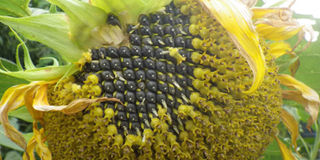Managing sunflower pests

To avoid pest infestation, farmers are advised to harvest their crop early. Pphoto by Lominda Afedraru
Sunflower is a common crop that is grown by many people in Uganda especially northern region. It is among the hardy crops that easily grow in a wide range of ecological zones.
It fetches high prices in the market and is rich in vitamins and fat, among other nutrients. However, growing the crop comes with several challenges that make farmers harvest losses.
Seeds of Gold visited a sunflower farmer recently and one of the things we noticed about the crops on one block of his farm is that some were yellowing while others had white substances on the leaves.
Seeds of Gold talked to Dr Moses Biruma the programme leader at the National Semi Arid Resources Research Institute (NaSARRI) about disease management.
Integrated pest management
Integrated pest management (IPM) is a sustainable approach to managing pests by combining biological, cultural, physical and chemical tools to minimize economic, health and environmental risks.
IPM maximises the effectiveness of chemical pesticides, while minimizing the impact on non-target organisms and the environment. The pests and diseases vary because some infest the leaves, the roots and the head as described below.
Wireworms
Wireworm larvae feed on germinating seeds or young seedlings. Infestations are more likely to develop where grasses, particularly perennial grasses, have been growing. Stems of young seedlings may emerge shredded. This leads to wilting and death of the plant.
Cutworms
Cutworms can be a serious problem in many field crops. The most common are the red backed, dark sided and dingy cutworms. The red backed cutworm majorly feed on vegetables and kitchen garden plants including spices.
Sunflower beetle
Feeding by adult beetles and larva may result in poor seed set, seed filling, reduced yields and delayed maturity. Sunflower beetles feed on native and cultivated sunflowers. They usually emerge from the soil.
Sunflower bud moth
High populations of this pest have been reported in the past. Despite high populations, the sunflower bud moth may not cause high levels of economic loss. Most of the infestations occur in the stalks and pith areas of the head. The only time yield loss is noticeable is when larvae burrow into unopened buds, preventing proper head development.
Maggots
They are of different species that have larval feeding stages that can cause seed sterility or stalk breakage under high populations. Damage is usually negligible.
Blackbirds
Sunflower seeds are particularly vulnerable to predation by blackbirds due to the high nutritional value, easy accessibility and heads serving as a perch during feeding.
Blackbird nests are built in dense vegetation, most often.
Control
“To control some diseases especially during rainy seasons, a farmer should have proper drainage on the farm, which can be achieved by creating channels that allow excess water to drain out,” says Dr Moses Biruma.




